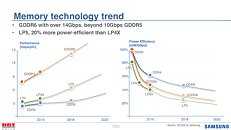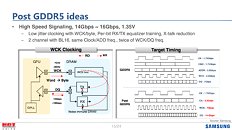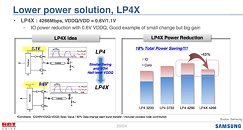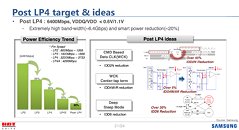- Joined
- Oct 9, 2007
- Messages
- 47,233 (7.55/day)
- Location
- Hyderabad, India
| System Name | RBMK-1000 |
|---|---|
| Processor | AMD Ryzen 7 5700G |
| Motherboard | ASUS ROG Strix B450-E Gaming |
| Cooling | DeepCool Gammax L240 V2 |
| Memory | 2x 8GB G.Skill Sniper X |
| Video Card(s) | Palit GeForce RTX 2080 SUPER GameRock |
| Storage | Western Digital Black NVMe 512GB |
| Display(s) | BenQ 1440p 60 Hz 27-inch |
| Case | Corsair Carbide 100R |
| Audio Device(s) | ASUS SupremeFX S1220A |
| Power Supply | Cooler Master MWE Gold 650W |
| Mouse | ASUS ROG Strix Impact |
| Keyboard | Gamdias Hermes E2 |
| Software | Windows 11 Pro |
Even as its fellow-Korean DRAM maker SK Hynix is pushing for HBM3 to bring 2 TB/s memory bandwidths to graphics cards, Samsung is betting on relatively inexpensive standards that succeed existing ones. The company hopes to have GDDR6, the memory standard that succeeds GDDR5X, to arrive by 2018.
GDDR6 will serve up bandwidths of up to 16 Gbps, up from the 10 Gbps currently offered by GDDR5X. This should enable memory bandwidths of 512 GB/s over a 256-bit wide memory interface, and 768 GB/s over 384-bit. The biggest innovation with GDDR6 that sets it apart from GDDR5X is LP4X, a method with which the memory controller can more responsively keep voltages proportionate to clocks, and reduce power-draw by up to 20% over the previous standard.




View at TechPowerUp Main Site
GDDR6 will serve up bandwidths of up to 16 Gbps, up from the 10 Gbps currently offered by GDDR5X. This should enable memory bandwidths of 512 GB/s over a 256-bit wide memory interface, and 768 GB/s over 384-bit. The biggest innovation with GDDR6 that sets it apart from GDDR5X is LP4X, a method with which the memory controller can more responsively keep voltages proportionate to clocks, and reduce power-draw by up to 20% over the previous standard.




View at TechPowerUp Main Site




